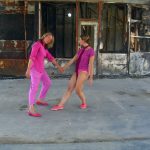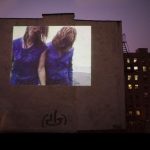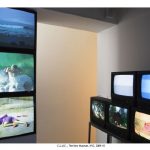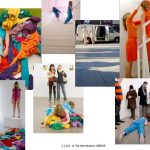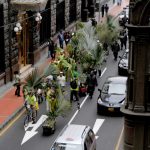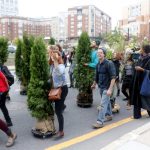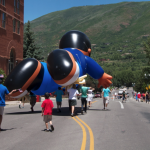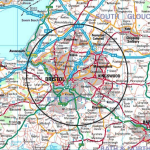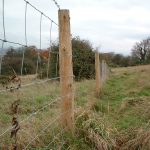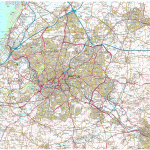“C.L.U.E. (color location ultimate experience) is a collaborative video, installation and performance work by artists A.L. Steiner + robbinschilds, with AJ Blandford and Seattle-based band Kinski. The performance and installation-based works have been presented in exhibition and performance venues internationally. The video works range from a single-channel piece (C.L.U.E., Part I), to multichannel pieces, up to 13-channels. ” (credit)
Category Archives: Humor
Lucia Monge, Plantón Móvil (2010-)
Lucia Monge (1983-)
“Lucia Monge started bringing people and plants together as Plantón Móvil in Lima, Peru. This is a participatory, walking forest performance that occurs annually and leads to the creation of public green areas.
“Plantón” is the word in Spanish for a sapling, a young tree that is ready to be planted into the ground. It is also the word for a sit-in. This project takes on both: the green to be planted and the peaceful protest. It is about giving plants and trees the opportunity to “walk” down the streets of a city that is also theirs. This walking forest performance culminates with the creation of a public green area.
Plantón Móvil started in 2010 while I was walking around Lima, my hometown, and noticing how many trees and plants had their leaves blackened with smog, were being treated as trash cans, or even used as bathrooms. I started to put myself in their place, and thought I would have left town a long time ago. Instead they are sort of forced to sit there and accept this abuse because of their planted “immobile” state. I wondered what it would be like to encounter a walking forest that had taken to the streets like any other group of people would do, demanding respect.
Plantón Móvil, however, is not a group of people carrying plants: at least for that time being we are the forest. I find it important to make this distinction because it changes the nature of the gesture. This is about lending our mobility to plants so that they can benefit from the speed and scale that draws people’s attention. In return; we may momentarily borrow some of their slowness. Essentially, it is about moving-with as a form of solidarity.” (credit)
Alex Villar, Temporary Occupations (2001)
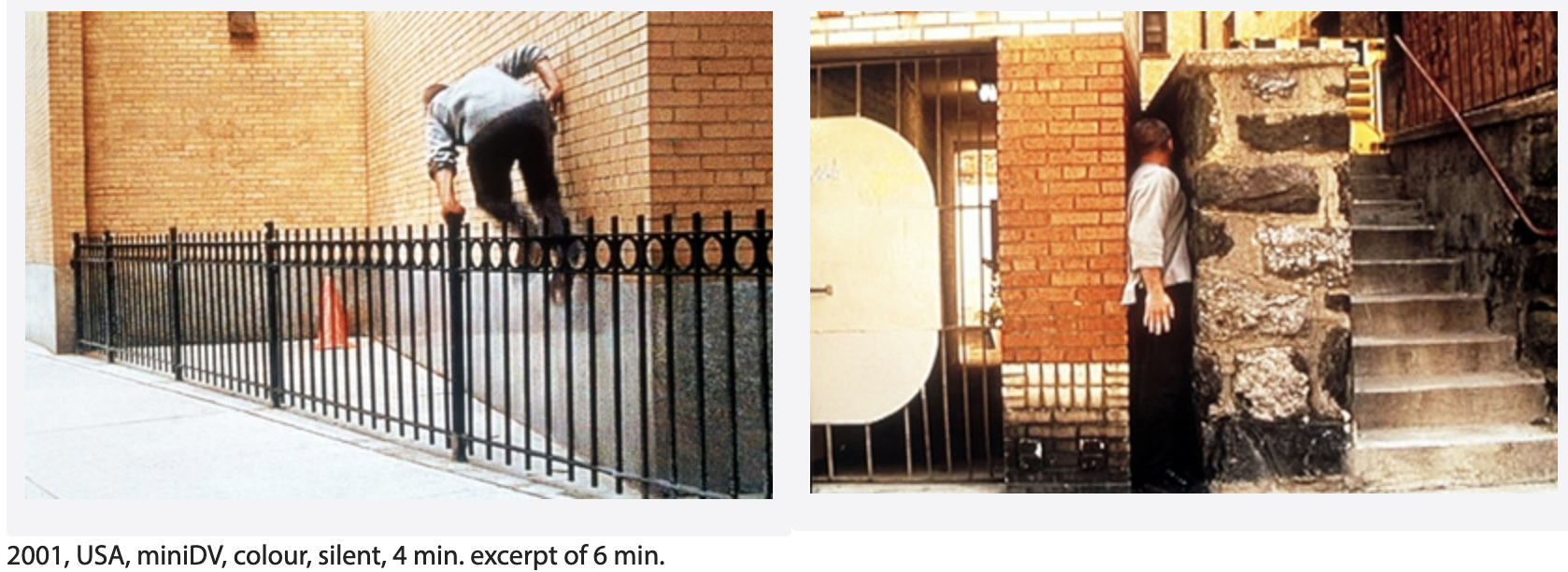
Alex Villar, Temporary Occupations, 2001, USA, miniDV, colour, silent, 4 min. excerpt of 6 min.
“Drawing from interdisciplinary theoretical sources and employing video-performance, installation and photography, I have developed a practice that concentrates on matters of social space. My interventions are done primarily in public spaces. They consist in positioning the body of the performer in situations where the codes that regulate everyday activity can be made explicit. The body is made to conform to the limitations of claustrophobic spaces, therefore accentuating arbitrary boundaries and possibly subverting them. A sense of absurdity permeates the work, counterpoising irrational behaviour to the instrumental logic of the city’s design.
Theoretical references cover the extensive work done on the problematic of space, especially the works of Foucault and de Certeau, which describe panopticon and heterotopic spaces as well as the potentialities for everyday re-writings of urban space. Aesthetic traditions foregrounding my work go from the sixties and seventies performative-based sculpture and installations by Hélio Oiticica, Lygia Clark and Cildo Meirelles, to the urban strategies of the Situationists and the anarchitecture of Gordon Matta-Clark. Like the in-between activities it seeks to investigate, my work lives between various fields: part nomadic architecture, part intangible sculpture and part performance without spectacle.
Temporary Occupations from alex villar on Vimeo.
Temporary Occupations depicts a person running on the sidewalk in New York while ignoring the city’s spatial codes and therefore resisting their effects upon the organization of everyday experience. The clips in the video register situations of temporary invasion and occupation of private spaces located in a public setting. The action simply articulates the continuity of these spaces with the remaining areas from which they were extricated, drawing attention to, and possibly subverting, the boundaries that demarcate them.
This piece is part of a long-term investigation and articulation of potential spaces of dissent in the urban landscape, which has often taken the form of an exploration of negative spaces in architecture.” (credit)
Robin Hewlet and Ben Kinsley, Street With a View (2008)
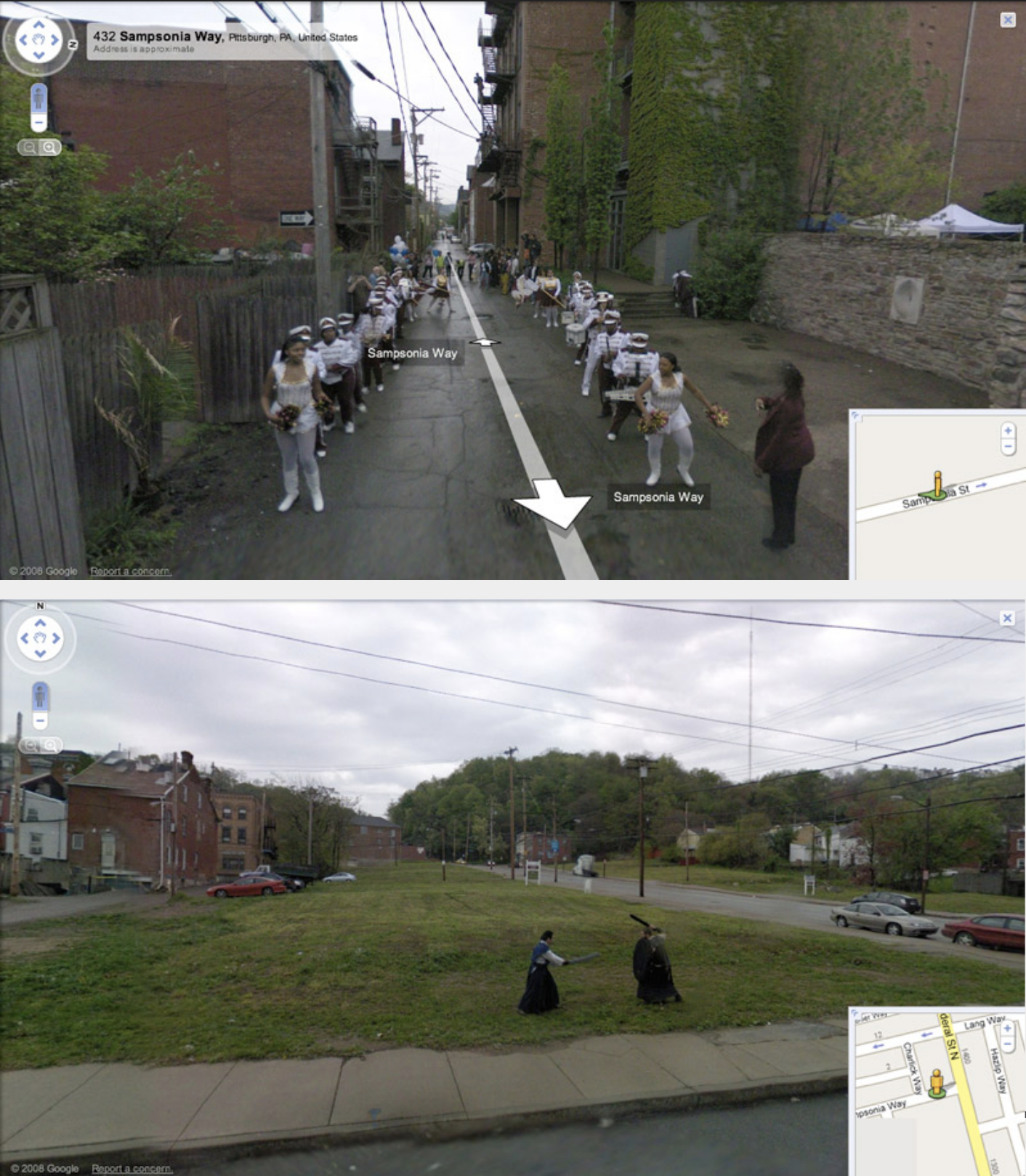
Hewlett and Kinsley invited the Google Inc. Street View team and residents of Pittsburgh’s Northside to collaborate on a series of tableaux along Sampsonia Way.
Technicians captured 360-degree photographs of the scenes in action and integrated the images into Street View.
Anna Campbell, Saddledrag (2006-)
Specific to the 2008 iteration: “As part of her ongoing performance series Saddledrag, artist Anna Campbell dressed in self-proclaimed “cowboy drag” and pulled a cast-plaster saddle behind her. In her own words, this cowboy without a horse “hopes to critique both the construct of the American cowboys, as well as nostalgia for a romantic past that never existed.” The saddle was fully eroded by the end of the trek, leaving a two-mile double line that encircled the full parade route.”
— Credit: Uchill, Rebecca, editor. On Procession, Indianapolis Museum of Art, 2009. Page 99.
The parade, overseen by Fritz Haeg and titled East Meets West Interchange Overpass Parade, was sponsored by the Indianapolis Museum of Art and was held on April 26, 2008.
Dave McKenzie, Dave (2010)
Dave McKenzie (1977-)
“Your retrospective features a parade-sized balloon which was previously used in another performance at the Aspen Art Museum. Could you talk about the object in this iteration? Particularly your ideas around metaphor and repetition?
The balloon was originally created for a July 4th parade in Aspen, Colorado, and was based on a video that I made called Watch the Sky. In Watch the Sky, I used television footage of the Macy’s Day Parade and then superimposed a caricature of myself over top of a character named Little Bill (a Bill Cosby character). What ended up in Aspen was a Frankenstein version of this image from Watch the Sky. Aspen is not a town known for its racial diversity, so when viewers of the parade saw this Black figure—one they could not identify and had no particular reference or even affinity towards—they tended to fill in the gaps by associating this Black male with any popular Black male they could conjure up. Obama, Lebron [James], etc. In the [retrospective], I think the balloon will have a number of functions and refer to a number of things—it is beautiful and ugly, full and empty, present and absent. It’s my body, maybe, but certainly like my body it is already historical and preconceived. Still, if I had to put my figure on one thing it points to and addresses it would be breath.” [credit]
TH&B, TH&B: Beachcombers (2016)
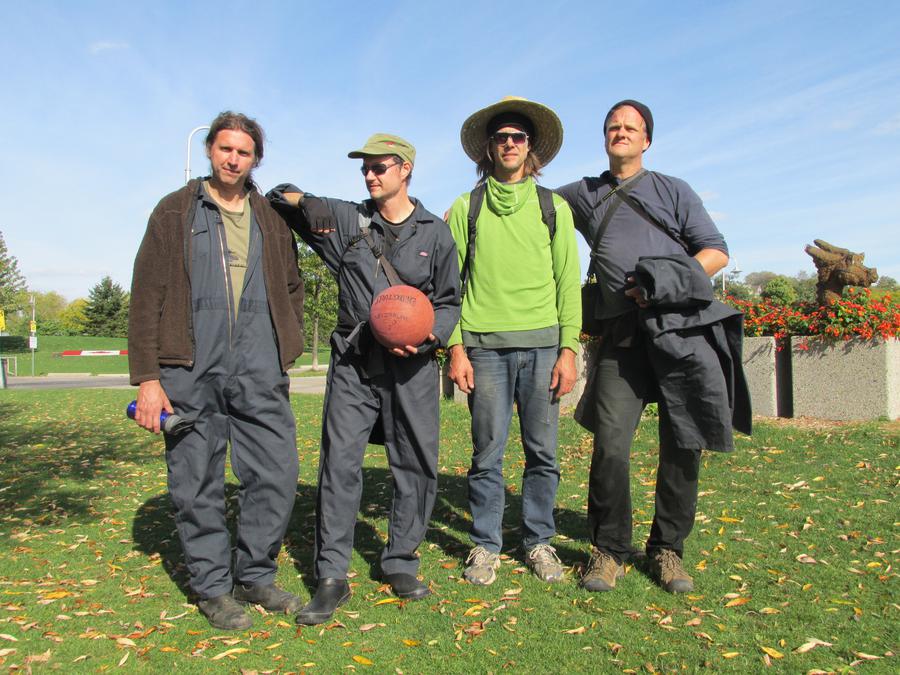
“Project Description:
In TH&B: Beachcombers, Hamilton collective TH&B (composed of artists Simon Frank, Dave Hind, Ivan Jurakic, and Tor Lukasik-Foss) stage an urban camping expedition at Ontario Place. In this durational performance, the group explores the West Island on foot and by canoe, producing an artwork that encompasses their process, their camp, and an installation built during their time there. A tongue-in-cheek response to narratives of wilderness exploration and discovery, TH&B: Beachcombers revels in the absurdity of scouring an artificial island, with the aim of collecting materials to create a rescue beacon. Referencing the 1970s kitsch exemplified by the Canadian TV show Beachcombers, TH&B’s performance combines industriousness, outdoor-savvy, and a healthy dose of humour.
Biography:
TH&B is the creative partnership of Simon Frank, Dave Hind, Ivan Jurakic and Tor Lukasik-Foss, a group of visual artists working out of Hamilton, Ontario. Resuscitating the moniker of the defunct railway that once serviced the Toronto, Hamilton and Buffalo rail corridor from 1895-1987 as a geographic marker, the team develops projects that response to site, context and history. Collaborating on all aspects of authorship and production TH&B investigates the intersection of rural, urban and industrial environments in the Great Lakes region.” [credit]
Lenka Clayton, The Distance I Can Be From My Son (2013)
The Distance I Can Be From My Son (Back Alley)
2013 / video series / 1:53 min
A series of videos that attempt to objectively measure the furthest distance I can be from my son in a variety of environments; a city park, a back alley and Shursave supermarket.
Made during An Artist Residency in Motherhood. [credit]
PJ Roggeband, Exhaust Garden (UITLAATTUIN) (2017-)
“Is there such a thing as portable green? What role can mobile nature play in the urban environment? The ‘Exhaust Garden’ offers a solution! Suppose you want to get away as a city dweller. You step into your portable garden, put on the shoulder straps and off you go: strolling through the busy city with your nose between the plants and grasses.”
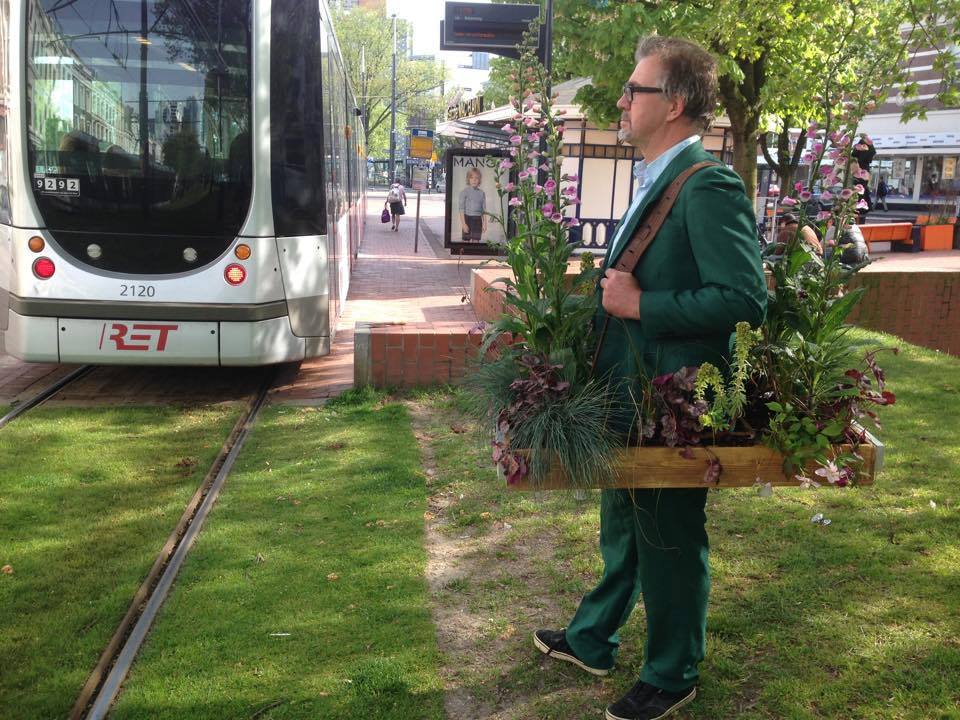
exhaust garden
“It all starts with a contribution to the ‘Hortus Conclusus’ exhibition in the Museum of Religious Art in Uden. In consultation with sculptor / landscape gardener Hans van Lunteren I make the ‘ENCLASS GARDEN’. The perspective within this portable garden has been reversed; it is nature that walls and shields man. The motif of the enclosed garden refers to the Garden of Eden or the Earthly Paradise where man lived in harmony with nature. The approach to paradise as something small and personal opens up interesting possibilities, of course.
Man destroys nature, man protects nature. The artists have played with this fact. They have reversed the perspective. With them, man is enclosed in a portable garden; the Homo Hortus Conclusus.
The square meter garden regularly goes outside, into nature, around the shoulders of people. The exuberant garden. Later versions of the ‘ENCLASS GARDEN’ have been developed specifically for the theme of an exhibition or respond to current events.”
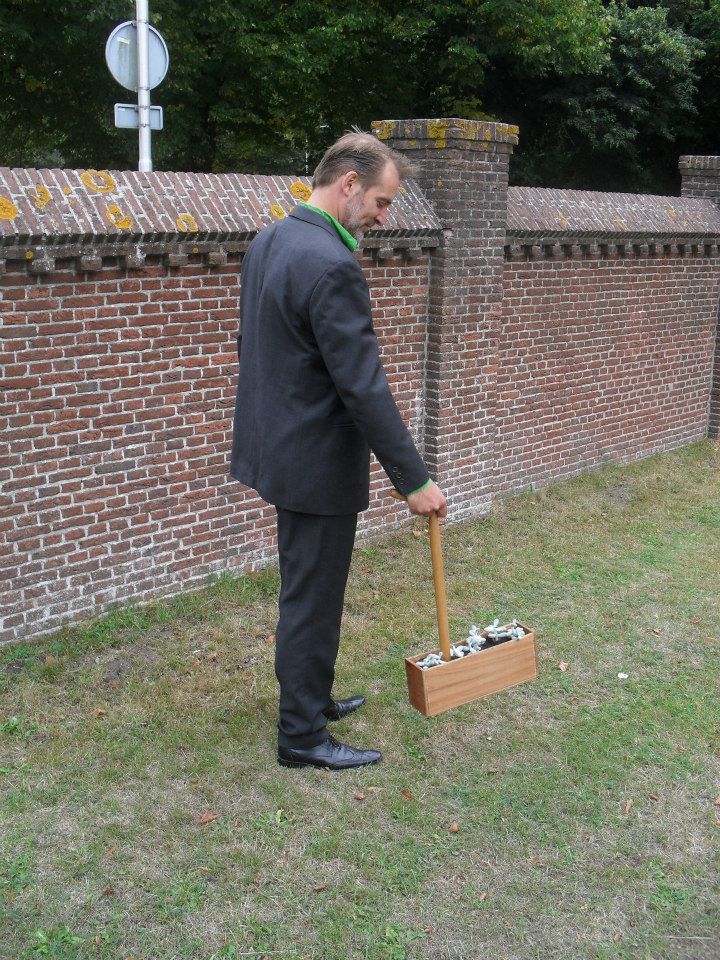
UITLAATTUIN-model-succulent
“When I notice a part of a hoe with the striking handle in addition to a wooden container intended for chalks and erasers among the waste at a primary school, a more manageable form of the ‘OUTLET GARDEN’ is born.
The ‘EXHAUST GARDEN’ has a wealth of possibilities. You can fill it with all kinds of herbs, vegetables or plants. You can of course make a statement by using your portable garden for endangered bees and butterflies. But you can also turn your garden into a mobile weather station, for example, by using guichelheil. Because the flowers of this plant close quickly when bad weather is on the way, guichelheil is also used as a (poor man) barometer.” [credit]
Heath Bunting and Kayle Brandon, D’Fence Cuts (2001)
“Heath Bunting emerged from the 1980s art scene committed to building open, democratic communications systems and social contexts. Throughout his career, he has explored multiple media including graffiti and performance art and has staged numerous interventionist projects, as well as being a pioneer in the field of Internet Art. Bunting began collaborating with artist Kyle Brandon in 2001.” [credit]
These artists devised a circular tour (see map), and by night stealthily cut some fences as part of their Borderxing project. BorderXing serves as a pratical guide to crossing major international borders, legally or illegally. It was a type of physical hacking of space, cutting anything that impeded their walk – D’Fence Cuts. Below is an excerpt from their tour de fence catalog:
“tour de fence is the answer to your real needs. while the internet promised to level out all barriers, tour de fence enables you to surmount the fences out there that people erect to obstruct your way every day. from wire netting to ru stic fence, from steel door to close security system, tour de fence offers you the necessary know-how for unhampered movement. tour de fence is the direct way.
learn offroad mobility within high security architecture. cross over stretches of land in the right direction. penetrate the underground area of your city. tour de fence puts an end to the relocation of your movements into virtual space. use the tour de fence! become a tour de fence amateur team. pass this handbook on to others. propagate tour de fence.
by doing so you will become part of the international tour de fence community. as a reader, a free-climber or by sending one of the 24 tour de fence postcard in this book.
participate now! tour de fence’s vision is to do what we want.
…
tour de fence acknowledges fence as metaphor for private property. fence as a supposedly temporary, often mobile barrier performing functions of inclusion and exclusion, entrapment and guided freedom, decoration, safety, user boun dary, protection from hazard, flow control, visual screening and user separation.
fence is a permeable filter system defining permitted use and users. light, wind, insects, water, plants and sound pass unhindered while high order life forms such as·humans, fish, cattle and cars are engaged:
development of fence.
up to now the vertical has generally been private while the horizontal public. increasingly, vertical fences are being rotated to the horizontal and enlarged over large areas of land, as all use and users are embraced in total control.
tour de fence recognises the transformation of framed freedom into restricted open-range roaming; the re-alignment of unknown possibilities into known re peatables. users are permitted to skate across flattened surface of fence, but not to pass through – the fence is everywhere.” (credit)
